Cheap and efficient heat carrier for a country house heating system - is it possible?

The heating system in a country house allows you to comfortably survive the harsh winter.
They apply air, infrared heating systems, but the most popular remain liquid heating devices.
The advantages of this method are obvious: high efficiency and economy, ease of adjustment.
The use of water leads to freezing of the heating circuit in emergency situations, so special heat carriers have become widespread - antifreezes, not afraid of low temperatures and adapted for heating systems.
What qualities should a coolant have?
In a water heating system, the heat carrier is the liquid that transfers heat from the boiler or heating element to the radiators in each room. For this purpose, a circulation pumps, are equipped with safety and control valves, therefore the following requirements are imposed on modern antifreeze:
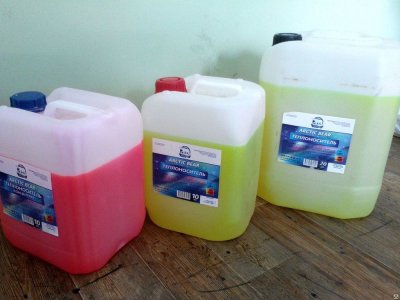
- Good heat capacity to transfer the maximum amount of thermal energy from the source to the consumer. Water has the highest heat capacity - 4220 J/kg*degree, glycerin and ethylene glycol have approximately twice as low.
- The range from the boiling point to the crystallization point should be as wide as possible. Modern antifreezes easily tolerate frosts up to -40°С and heating up to 100°С.
- Chemical inertness liquids in relation to metal and plastic units of the heating system. Particularly susceptible to corrosion iron and aluminum parts.
- The composition of the coolant should not lead to the formation of scale on the walls of pipes and heat exchangers.
- Safety for humans during repair work.
- Preservation of physical properties over time entire service life, does not decompose into its constituent components even after prolonged inactivity.
- Low cost.
For many, the ideal coolant is simple water — it is safe, accessible, and retains heat for a long time. Water is used in houses of permanent year-round residence. Summer cottages with seasonal residence are best heated with an antifreeze heating system. The risk of freezing pipes with the onset of cold weather is minimal.
Water
There are country-type heating systems open and closed type. In the first case, a non-hermetic tank with a lid is installed, where water is constantly added to replace the evaporated one. In a closed one, the liquid circulates inside the circuit without contact with the external environment. An expansion tank is used to compensate for the pressure.
Advantages water:
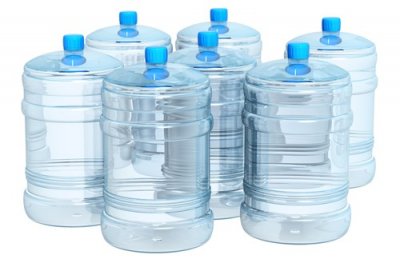
- Cheap and easily accessible in Russia. It is easy to refill the system with liquid at any time. Specially prepared water is available for autonomous heating systems.
- Thermal characteristics. One liter of water is able to convey to the end consumer up to 20 kcal when the temperature drops by 20°C.
- Harmless for the consumer and the environment heat carrier. An accident or leak will only lead to flooding of the premises without serious consequences. It has no smell or dangerous fumes, fireproof.
Flaws:
- Freezing water increases in volume by 10%, Therefore, the entire water circuit will be damaged if the liquid is not drained for the winter.
- Dissolved oxygen - strong oxidizing agent. Leads to corrosion of metal parts and pipes. Aluminum and plastic do not corrode under the influence of water.
- Regular tap water contains a lot of dissolved salts and minerals (calcium, magnesium, iron, sulfates, carbonates), which lead to the formation of scale. Limescale on the walls of the boiler and heating radiators worsens thermal conductivity and reduces the efficiency of the entire system.
- Requires regular replacement the entire volume of coolant and flushing of pipes.
Reference! Top up the cooling system distilled water. You can buy it in auto stores or assemble the rain water yourself and pass it through a filter.
To reduce the harmful effects of water on pipes, it must be thoroughly filter or give stand for a few days, then drain off the residue. Subsequent boiling helps to significantly reduce the content of hardness salts. Chemical softening is carried out using soda ash and sodium orthophosphate. The dissolved salts will precipitate, and the clean water is drained.
Antifreeze liquids
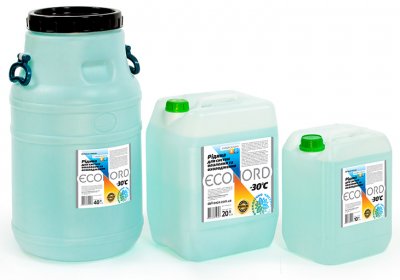
All liquids with a freezing point below zero degrees are called antifreezes (from English antifreeze).
Antifreezes do not freeze even in severe frost, they become more viscous, gel-like, lose fluidity, but never turn into a solid state.
Popular antifreezes are made on the basis of water with the addition of polyhydric alcohols: propylene glycol, ethylene glycol and glycerin.
Pros antifreeze versus water:
- Crystallization onset temperature of concentrate minus 65-70°C, even diluted with water, such a coolant does not freeze at -30°CThis is enough for the central part of Russia.
- The service life of a good antifreeze is 5 years. Special additives in the composition allow maintaining properties until the end of the warranty period.
- Chemical neutrality antifreeze components. The liquid does not react with metals, does not destroy plastic, and does not form scale on the walls.
Flaws:
- Heat capacity is less than water by 15-20%. This means that the boiler needs to be heated more strongly and more sections in heating radiators to achieve good heat transfer.
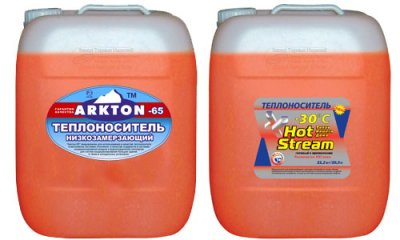
- Natural circulation is not suitable for antifreeze based heating systems. Due to the higher viscosity, installation will be required. transfer pump.
- High penetrating power through detachable connections and seals. High fluidity and aggressiveness of some liquids requires a special approach to the assembly of the heating circuit and the use of paronite and silicone gaskets instead of rubber.
Attention! The absence of water leaks does not guarantee that antifreeze will hold in this system.
- High toxicity ethylene glycol-based heat carriers only allow the use of closed, hermetically sealed heating systems. Such antifreezes cannot be used in dual-circuit heating systems where there is a risk of water entering the hot water supply.
Antifreezes for domestic heating systems are painted in bright colors, to quickly detect a leak, and are sold in concentrated form. Dilute with water in the required proportion according to the instructions.
Ethylene glycol antifreezes
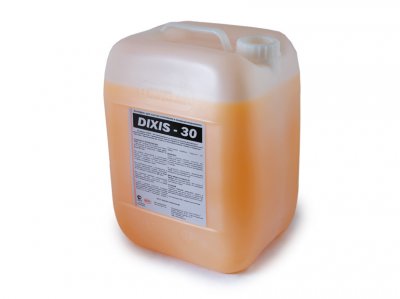
Ethylene glycol has gained wide distribution in the market of cooling liquids and heat carriers due to ease of production and low cost. It is used in automobiles and home heating systems.
Ethylene glycol fluids operate in the range from -65°С to +90°С, and the decomposition temperature is the highest: 170°С. In this case, precipitation begins already at +110°С, which makes it inapplicable in solid fuel boilers.
A feature of ethylene glycol is the nonlinear dependence of the freezing temperature on concentration. Thus, 100% ethylene glycol loses fluidity when -13°C, and 64% solution remains mobile when -65°С.
Flaws:
- High chemical activity, a tendency to foaming and sedimentation. Inhibitory additives to antifreeze achieve 4%.
- Destroys galvanized coating, aggressive to aluminum alloys.
- Overheating of the coolant leads to the formation solid sediment, which clogs the channels and impairs heat exchange. The acids released in this process cause corrosion.
- High toxicity of the solution and its vapors. Regular inhalation of ethylene glycol vapors leads to disorders, and small ingestion leads to severe poisoning and even death.
Propylene glycol antifreezes
A modern and safe alternative to ethylene glycol. Its main advantage is safety and chemical inertness. Freezing temperatures up to -30°С, and boiling up to 110°СOverheating occurs at high temperatures, but sediment does not form and the composition is not destroyed.
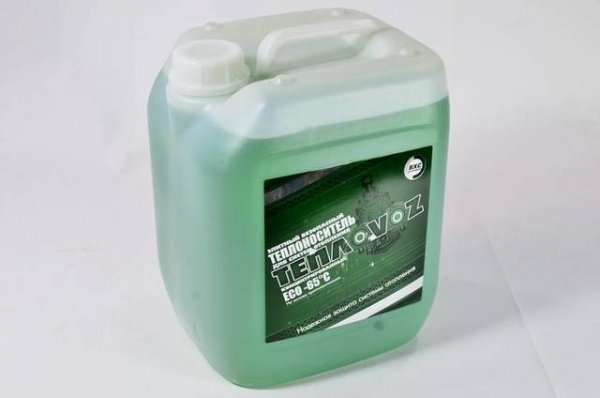
Photo 1. Heat carrier based on propylene glycol Eco-65, 20 kg, manufacturer - "Teplovoz".
Pros propylene heat carriers before ethylene glycol:
- High heat transfer properties and stability of operation in the heating system.
- Excellent fluidity through pipes and lubricating effect on all moving parts.
- Harmlessness propylene glycol. Not dangerous if it comes into contact with the skin or gets inside the body.
Flaws: reacts with the zinc protective coating, high price per 1 liter.
Important! There are antifreezes for operating temperatures over 180°C based on triethylene glycol. They are distinguished by high stability of physical and chemical properties under strong heating. They are rarely used in suburban heating systems.
Glycerin liquid
Glycerin is a liquid substance of the glycol group, therefore it has approximately the same properties as propylene glycol coolants. Glycerin freezes at -30°С and does not like strong overheating. The upper working limit about 100°C. Before using glycerin in a heating system, it is worth considering all of its features.
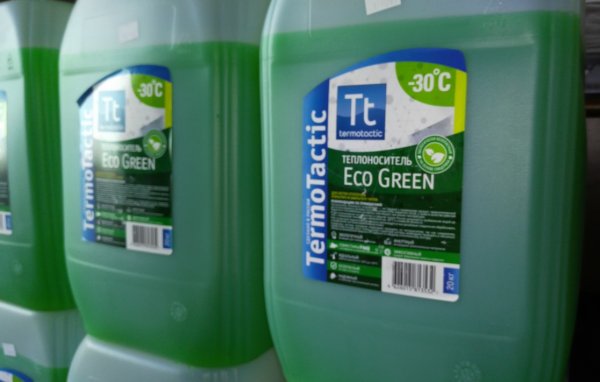
Photo 2. Glycerin-based heat carrier Eco Green, 20 kg, manufacturer - Thermo Tactic.
Pros:
- safety for a person;
- when freezing does not expand;
- does not spoil galvanizing and rubber gaskets;
- explosion-proof, does not burn;
- simplicity in use;
- service life up to 10 years;
- cost of 1 liter lies between ethylene glycol and propylene glycol antifreezes.
Flaws:
- high density of glycerin means a large mass of liquid in the heating system and increased loads;
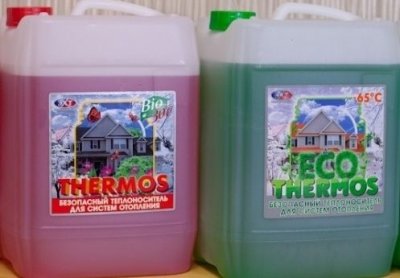
- high viscosity quickly disables pumping equipment;
- poor heat capacity;
- when heated strongly, it decomposes into insoluble fractions;
- foaming without additives leads to air locking in the system;
- deterioration of properties with gradual evaporation of water, thickening;
- absence single standard for glycerin liquids, each manufacturer has its own specifications.
Glycerin was used in car cooling systems back at the beginning of the 20th century. Since then, a worthy replacement has been found, primarily due to its low performance properties. Therefore, it is worth using glycerin heat carriers in a private home with an eye on the characteristics and operating conditions.
Selection and use of coolant for the heating system of a country house
An analysis of the operating conditions and the type of heating device will help you make a choice in favor of one or another antifreeze. Thus, electric or gas boiler with automatic temperature control function, allows the use of glycerin or ethylene glycol solutions. Solid fuel — are prone to overheating in the heat exchanger area, so filling the system with water would be optimal.
Regular residence in the house reduces the risk of the system freezing. Water with added surfactants will be the ideal option in this case in terms of price-quality ratio.
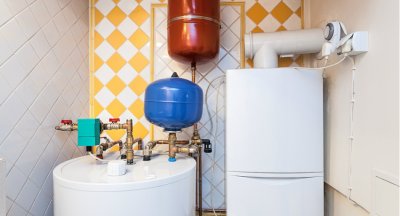
Before filling the circuit with antifreeze, you should inspect all connections, taps, valves and pumps.
The expansion tank must be 20% more, than for water, and the increased cross-section of pipes will improve heat exchange in the house.
Fill the system with antifreeze by gravity, through an air valve at the highest point. After which the liquid is driven through using a suitable pump (car). The second method will require a submersible pump. for water, which is connected to the lower point of the circuit through a check valve. Filling with coolant goes from the bottom up.
Useful video
Check out the video that talks about the pros and cons of different coolant options.
How much will it take?
The choice of antifreeze has been made, all that remains is to find out how much will need to be poured into the heating system. There is three ways how to do it:
- Remember water meter readings and fill the entire circuit completely through a separate hose. The difference in readings will be the desired volume.
- Drain all liquid through any measuring container with a known volume.
- Calculate using special calculator approximate internal volume using data on the cross-section of pipes and the type of heating radiators.
When buying ready-made antifreeze, take it into account concentration and volume after diluting with water. It is also not worth saving on it, a quality product will last a long time and will not cause problems.







Comments